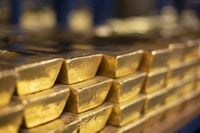The global gold market is in the midst of a historic rally, with spot prices smashing through the $3,700 per ounce barrier for the first time on September 16, 2025. According to reporting from Futunn News and OANDA, gold reached an intraday high of $3,702.93 before closing at $3,689.60, marking a cumulative 41% increase in 2025 alone. Early Asian trading the next day saw gold holding steady near these record levels, with spot prices at approximately $3,691.23 per ounce. This surge is far from a fluke; it’s the result of a potent mix of Federal Reserve policy expectations, a sharply weakening U.S. dollar, robust central bank buying, and persistent geopolitical uncertainty.
The primary engine behind gold’s meteoric rise? Market anticipation of a Federal Reserve interest rate cut. The CME Group’s FedWatch tool shows traders almost unanimously expecting a 25-basis-point cut at the Fed’s September 17 meeting, with a small but notable 4% betting on a 50-basis-point move. President Donald Trump has added fuel to the fire, publicly pressuring Fed Chair Jerome Powell for a "larger" rate cut. As OANDA analyst Zain Vawda put it, "Although safe-haven demand and central bank gold purchases have provided support, the main driver of this gold price rally remains the market’s pricing of aggressive Fed rate cuts." In a low-rate environment, the opportunity cost of holding gold—a non-yielding asset—shrinks, making it more attractive to investors seeking shelter from economic storms.
The U.S. dollar’s dramatic slide has also played a crucial role. On September 16, the dollar index fell to its lowest since July 24, hitting two-and-a-half-month lows against the euro and more than two-month lows against the British pound. The Australian dollar saw its strongest performance since last November, buoyed by robust Asian stock markets. According to independent metals trader Tai Wong, "Gold prices surged due to significant dollar depreciation, but ahead of the Fed’s decision, market sentiment has turned cautious, and some profit-taking may temporarily limit gains." The dollar’s weakness isn’t just about rate cut expectations; it also reflects investor jitters about the U.S. economy’s outlook, with labor market softness and inflationary pressures from tariffs undermining confidence. Even strong August retail data couldn’t offset these worries.
Gold’s time-honored role as a safe haven is shining brighter than ever. With global economic growth uncertain and geopolitical flashpoints multiplying, investors are flocking to gold for its perceived stability. Central banks have been major players in this trend, steadily accumulating gold throughout 2025. As long-term buyers, central banks are less swayed by short-term price swings, creating what analysts describe as a "positive feedback loop" that supports prices even as speculative investors take profits. This structural demand, according to Futunn News, has helped gold’s price resilience "far exceed historical levels."
The rally isn’t happening in a vacuum. Global financial markets are interconnected, and gold’s ascent is closely linked to broader trends in interest rates and exchange rates. The Bank of England and Bank of Japan are both set to announce rate decisions this week. While the Bank of England is expected to hold steady, the Bank of Japan is likely to keep its rate at 0.5%. Diverging policies among major economies could further roil currency markets, amplifying gold’s appeal as a hedge. U.S. Treasury yields tell a similar story: the 10-year note edged down to 4.028%, near a five-month low, as investors focused on the risk of economic slowdown rather than short-term data. The 10-year TIPS breakeven yield remained stable at 2.37%, suggesting markets believe the Fed still has room to maneuver against downturns.
Global stock markets are also in record territory, with the MSCI All Country World Index posting a ten-day winning streak—its longest in over four years—according to OANDA’s Asia Market Wrap. Japanese indices Nikkei 225 and Topix hit all-time highs, while the Hang Seng in Hong Kong eked out a slight gain. European stocks, on the other hand, slipped slightly, with the STOXX 600 down 0.15% due to declines in banking and insurance sectors. On the currency front, renewed calls from President Trump for aggressive Fed easing have further pressured the dollar, lifting other major currencies and adding momentum to gold’s rise.
The gold rally isn’t just a boon for investors; it’s having tangible effects on the mining industry. In Kazakhstan, Solidcore Resources—formerly Polymetal International—has seen its fortunes swing with the price of gold. As reported by Reuters via Global Banking and Finance Review, Solidcore’s CEO Vitaly Nesis said, "For 2025, the gold price will largely offset the 11% downward revision to the production forecast." Sanctions-related disruptions to concentrate shipments to Russia caused a 58% drop in first-half profits, but soaring prices and improved sales in July and August have helped stabilize the company. Solidcore continues to send gold concentrate to Russia’s Amursk plant under a tolling arrangement, with plans to launch its own Ertis facility by 2028. The company aims to secure $500–$600 million in financing for the project in early 2026.
Yet not everyone is convinced the rally can last. Solidcore’s Nesis cautioned, "I think there will be some decline. I wouldn’t be surprised if (the price of gold) drops to $3,200 by the end of the year." The company has postponed potential acquisitions in Central Asia, citing surging asset prices and seller expectations that are "not yet ready to significantly raise our offer." This note of caution is echoed by analysts who warn that if the Fed’s rate cut or guidance is less dovish than markets expect, gold could see a technical correction.
For now, all eyes are on the Federal Reserve’s upcoming decision, set for 2:00 AM Beijing time on September 18, followed by a press conference with Chair Powell. Investors are also monitoring U.S. housing data, the latest developments in U.S.-China trade talks, and President Trump’s state visit to the UK—each of which could inject fresh volatility into the markets. Meanwhile, the Bank of England faces its own conundrum: UK wage growth has slowed to its lowest rate since May 2022, with real wage gains of just 0.7% after inflation. This cooling job market could pave the way for another rate cut later in the year, depending on how inflation data pans out.
As of 06:50 Beijing time on September 17, spot gold was trading at $3,691.31 per ounce, still hovering near its all-time highs. Whether this supercycle can be sustained depends on a delicate dance of central bank decisions, currency moves, and global economic developments. For investors, the message is clear: short-term volatility may be inevitable, but gold’s status as a strategic asset in uncertain times remains unchallenged.





